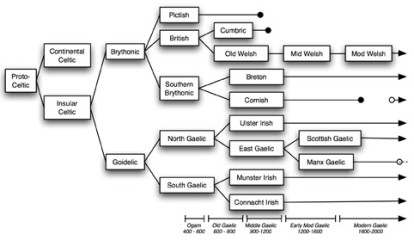"An t-seann chànan Albannach"
What is “Celtic”?
"Celtic" is a branch of the Indo-European language family, like English (which is part of the Germanic language family). The means by which the Celtic languages became established in Europe, and the time period in which this occurred in various regions, is currently a matter of research and speculation. The earliest linguistic evidence dates back to around the 6th century BCE in the form of Lepontic inscriptions, found in northern Italy.
There are four Continental Celtic languages: Lepontic, Celtiberian, Gaulish, and Galatian. These languages became extinct in the first few centuries after the Roman conquest, although they have left traces in languages such as German, French, and English. Most of our information about these languages consists of short inscriptions, including Gaulish written on cursing tablets and spindle whorls, the Celtiberian Bronze of Botorrita, Lepontic inscriptions on stone, and bilingual inscriptions in Latin or Greek and Gaulish.

Diagram of Celtic languages of British Isles
(Michael Newton, 2008)
The Insular Celtic languages, that is to say, the Celtic languages of Ireland, Britain, and Brittany are traditionally grouped into two main branches, Goidelic ("Q-Celtic") and Brythonic (or British) ("P-Celtic"), because of a phonetic divergence that is thought to have developed in very ancient times, which developed into a q or p respectively (this explains for example why the word for 'son, boy' is macc in Old Gaelic, but mab in Middle Welsh). The Goidelic branch eventually split into three different languages in the medieval period: Irish Gaelic, Scottish Gaelic, and Manx Gaelic.
A Short History of (Scottish) Gaelic
It is still unclear when the Celtic languages arrived, or developed, in the British Isles or how. At the time of the Roman occupation, the territories now claimed by the modern nation we call "Scotland" was inhabited by people speaking forms of Goidelic and Brythonic languages. It is only due to the Roman presence that divisions emerged in the Brythonic branch which led to the use of the labels "Pict" and "Briton." It is similarly unclear when Celtic languages arrived, or developed, in Ireland; estimations vary from around 1000 BCE to around 100 CE.
By about the 12th century, Brythonic speakers on the mainland had adopted the Gaelic language, although Brythonic influences were imprinted on Scottish Gaelic. Similarly, the Norse who settled the Western Isles and the western seaboard of the mainland had become Gaelicized.
The term Scot originally referred to a Gaelic speaker, whether they were living in Scotland or Ireland. The kingdom of Scotland was built and dominated by Gaelic-speaking kings, saints, churchmen, and warriors, and this label stuck to Scotland rather than Ireland. At its height in the 12th century, Gaelic was spoken in most parts of Scotland, and even south of the English border.
English-speaking peoples settled in the Lothians of south-eastern Scotland in about the 6th century. The influence of the English language expanded during the reign of David son of Malcolm Canmore when he planted burghs and military outposts in many other parts of the Lowlands of Scotland after becoming king of Scotland in 1124. David brought people from the north of England and the Low Countries of Europe to the burghs, which introduced a new social order, and language, to Scotland which soon dominated the Lowlands. The people of the Highlands, however, held on to their identity as the "Old Scots" and to their ancestral language, Gaelic.
Until the 17th century, Gaelic Scotland and Ireland were linked by a literary form of Gaelic, by dynastic intermarriage, and by the exchange of professional Gaelic scholars, poets, churchmen, lawyers, and warriors. These bonds were broken at the same time that Gaeldom in both Scotland and Ireland was besieged politically, culturally, and economically by the English-speaking world. The fortunes of the language were tied to the native nobility; when they were assimilated or exiled (during the 17th century in Ireland, and the 18th century in Scotland), Gaelic lost the crucial infrastructure and patronage it needed to ensure its development and survival.
Some Milestones of (Scottish) Gaelic Literature
- c. 400 AD - Creation and use of ogam alphabet (for funerary inscriptions on stones)
- c. 563 - the Irish saint Colum Cille (St. Columba) founds monastery of Ì (a.k.a. "Iona")
- c. 597 - Gaelic elegy composed on death of St. Columba by Dallán Forgaill
- c. 600 - The book Cathach written (by St. Columba?)
- 6th/7th century - Gaelic law begins to be transcribed and first poems by poets like Senchán Torpéist and Luccreth moccu Chíara are written down
- ca. 650 - Date of the prima manus of the Würzburg glosses, some of the earliest dateable text in Old Gaelic.
- 697 - Cáin Adomnáin (Law of Innocents) accepted as law by 50 Irish kings, king of Dál Riata, king of Picts
- 908 - Death of Cormac mac Cuilennáin of Munster, purported compiler of Sanas Cormaic, the first etymological dictionary for Gaelic
- 1100s - writing of Lebor na hUidre, one of the earliest Gaelic manuscripts containing saga texts
- 1100s - Scottish Gaelic notes written in the margins of the Book of Deer
- c. 1200 - Muireadhach Ó Dálaigh brings Classical Gaelic syllabic poetic tradition to Scotland, composes praise poems for Earl of Lennox and Amhlaíbh of the Lennox
- c. 1220 - Gaelic poem composed in praise of Domhnall mac Raghnaill, King of the Isles and founder of Clan Donald
- 1300s - Scottish Gaelic charms written in the Murthly Hours
- 1403 - Commentary on the Aphorisms of Hippocrates translated into Classical Gaelic
- 1408 - Domhnall of Islay, Lord of the Isles, writes Gaelic charter for lands to Brian Vicar MacKay
- 1513-42 - Book of Dean of Lismore written, including compilation of Gaelic poetry
- 1567 - Gaelic translation of Book of Common Order becomes first book printed in any Celtic language
- c. 1596 - Donnchadh Albanach Ó Conchubhair copies Gaelic medical treatise at Irish medical college
- c. 1630 - Gaelic translation of Calvin's Catechismus Ecclesiae Genevensis published
- 1726 - Death of Niall MacMhuirich, scribe of the Red Book of Clanranald
- 1741 - First Scottish Gaelic vocabulary printed (compiled by Alasdair mac Mhaighstir Alasdair)
- 1751 - Alasdair mac Mhaighstir Alasdair becomes first Gaelic poet to publish his own book
- 1776 - Eigg Collection becomes first published collection of traditional Gaelic poetry
- 1785 - First Gaelic proverb collection published
- 1807 - Translation of entire Bible into vernacular Scottish Gaelic published
- 1860 - Publication of Popular Tales of the West Highlands in 4 volumes
Contact
207 Immaculata Hall
2360 Notre Dame Avenue
Antigonish NS B2G 2W5
Canada

